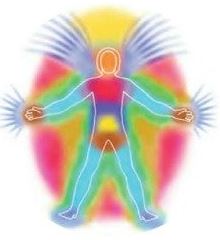It is often said that we are not human beings having a spiritual experience but spiritual beings having a human experience. What does this mean, and does it have any relevance for people not of a religious persuasion? Or does this religious language obscure the truth behind this statement?
There is a part of us that not only thinks and feels but is also aware that we think and feel and can step back and observe these thoughts and feelings.
Try this:
Set aside 15-20 minutes. Take yourself to a quiet place. Close your eyes. Be quiet and still.
Experience the sensations in your body. Be aware of that part of you which is observing those sensations. Affirm:
- I am not those sensations.
- I am not this body.
Then be aware of the thoughts going round in your head. Then turn your attention to the part of you that is observing the thoughts. Affirm:
- I am not these thoughts.
- I am not my thoughts
Then become aware of your emotions. Turn your attention to the one who is observing those emotions. Affirm:
- I am not these emotions.
- I am not the….. (anxiety, anger, guilt, fear etc.)
Finally take your attention to the part of you that is observing all these. Feel the life force flowing through you. Affirm:
‘I am a spiritual being. My essence is non-physical. I manifest my real Self through this body now.’
When ready, open your eyes.
A point of light
This exercise highlight a scientific truth confirmed by traditional spiritual teachings AND modern science: Appearances are not our essence.
We’re paradoxes – we live in mortal bodies and are at the same time non-physical. Something brings life to your body but can’t be seen, heard, held or touched. Some call it consciousness. Ironically this is the only part of us that is real and unchanging.
The spark of consciousness within us is sometimes portrayed as a point of light. Most science fiction fans are familiar with alien life forms that suddenly vanish into a point of light. Perhaps you would like to think of your spiritual essence this way.
The difference it makes to your life
When you consider yourself to be just a physical being of flesh, soft tissue, muscle and bone, your identity is based on your body and its needs. Your self-image revolves around its size, shape, age, health, sexuality and colour. You compare yourself with other bodies, categorising and labelling them. You describe yourself in terms of your roles. Your values are based on material things and your happiness achieved (deceptively) through sensory stimulation.
Contrast this with how we feel about ourselves when we recognise our non-physical essence. Now, we describe ourselves in terms of our character, aptitudes and talents. We look beyond appearances to the reality of who others are – spiritual beings just like ourselves. Above all, we don’t need to rely on things to be happy – we are happy just being. we’re aware of our inner power.
And that’s a huge change in perception.
©David Lawrence Preston, 16.6.2016
Follow me on Facebook and Twitter @David_L_Preston
How to Books, 2007





